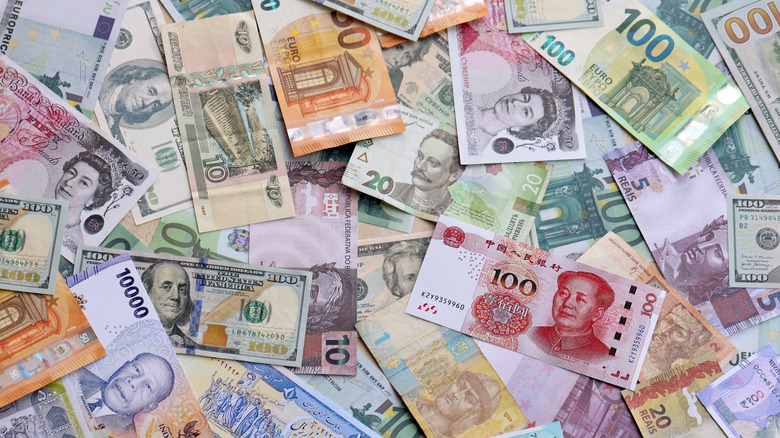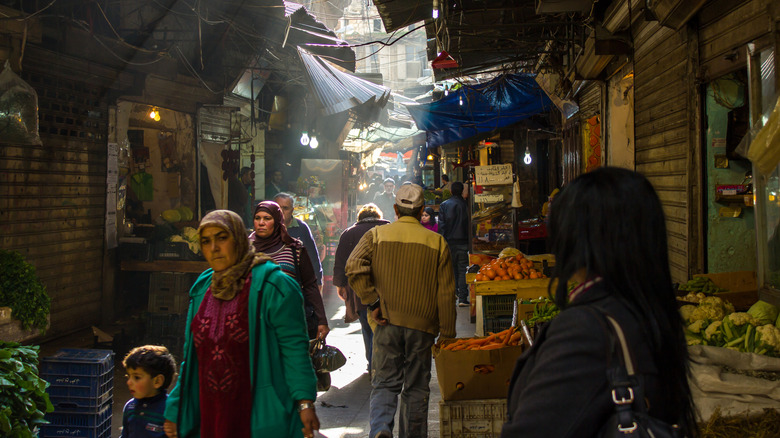The World's Least Valuable Currency Isn't In Europe, The Americas, Or Africa
A currency is considered the world's least valuable when it takes the highest number of local units to get to just one U.S. dollar in the market — a sign of the U.S. dollar's strength. By that yardstick, the Lebanese pound (LBP) ranks lowest in the world. Wise's 2025 list of global exchange rates puts the LBP at the bottom, well below other troubled currencies like the Iranian rial or Sierra Leone's leone. As of early July 2025, it takes about 89,600 Lebanese pounds to equal one U.S. dollar.
However, the LBP wasn't always ranked so low. Lebanon's financial crisis grew out of deep-rooted corruption. In 2019, Transparency International scored the country just 28 out of 100 on its Corruption Perceptions Index — signifying the country's government was highly corrupt. This rating proved accurate in 2022 when European prosecutors accused Riad Salameh, who led the country's central bank for decades, of taking about $330 million from Lebanon's central bank between 2002 and 2015. Not long after, the World Bank described Lebanon's economy as a "Ponzi finance scheme," accusing it of being run for only a small elite.
With the country's federal reserves drained, the central bank attempted to slow the fall of its currency by adjusting official exchange rates, from 1,507.5 to 15,000 pounds per U.S. dollar, in February 2023. Yet, this rate was still far behind what people were actually paying on the street. An-Nahar reported that, by the end of the first week of February 2023, the black-market rate broke past 60,000 LBP per U.S. dollar.
The crisis that kept on giving
Every nation has its challenges — Europe's largest economies are shrinking, and the United States may be headed for a recession. But it takes a much deeper crisis for a currency to hit rock bottom and Lebanon's currency did not go down overnight. In October 2019, Lebanese banks blocked customers from sending their money abroad and began limiting cash withdrawals, a move that badly shook public trust. Five months later, in March 2020, the government defaulted on $1.2 billion of its foreign debt, the country's first-ever default.
Lebanon now runs three different exchange rates instead of one. The old official rate of 15,000 pounds per dollar still appears in government accounts. However, in late 2022, the country's central bank introduced a separate rate starting at 38,000 pounds. Meanwhile, the street market, where most people actually get their money, trades far higher, often over 100,000 pounds to the U.S. dollar. By mid-March 2023, cash dealers were asking for between 121,000 and 140,000 LBP for one U.S. dollar.
Whenever the government offers cheaper dollars through one of these channels, it simply prints more LBP to cover the cost. However, in September 2023, the International Monetary Fund warned that this kind of money-printing to cover public expenses would only keep inflation in the triple digits, while also quickly draining the country's foreign currency reserves. By early 2025, the World Bank reported that Lebanon's gross domestic product (GDP) had contracted by close to 40% since 2018.
Living with the world's weakest currency
Lebanon's currency has lost nearly all of its buying power. According to the U.N.'s Economic and Social Commission for Western Asia, the LBP lost about 82% of its value between 2019 and 2021. By 2024, the World Food Programme estimated the total loss at over 98%, with food prices in pounds rising 6,500% compared to pre-COVID numbers. Because of this, many shops and service providers now use U.S. dollars instead. During a visit to Beirut in March 2023, Reuters found stores and gas stations posting dollar prices directly, as the LBP's value changed too quickly to continually update price tags.
A 2022 Human Rights Watch survey of Lebanese households found that nearly 70% were struggling to afford essentials like food and rent, while the median monthly income had dropped to just $122. According to the World Bank's 2024 country brief, poverty has more than tripled over the past decade, affecting 44% of the population. Citizens are paid in LBP that lose value by the day, but must still cover groceries, fuel, and school fees, most of which are now priced in U.S. dollars. About 30% of the Lebanese population face food insecurity, as of 2025, with the World Food Programme estimating that 2.5 million people in Lebanon needed food assistance in 2024, or about 40% of the country.


